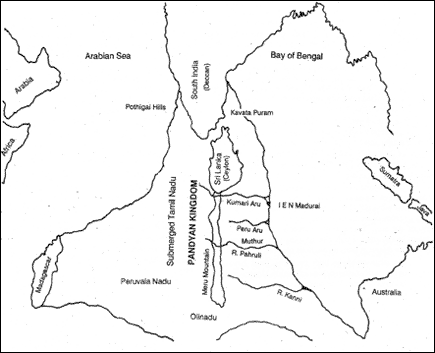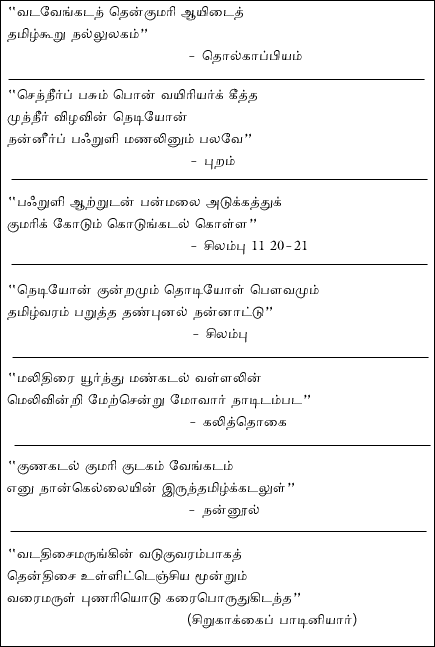Tsunami Disaster & Tamil EelamCatastrophes of the past in Tamil Aham:
poetic exaggeration or scientific facts?
7 January 2005, TamilNet [see also The Tamil Heritage - Tamils are an ancient People]
“To the ancient Tamil world natural calamities like the tsunami that hit the east coast on 26 December 2004 is not unknown,” says Professor A.Shanmugathas, head of the department of Tamil, Jaffna University. The Sangam Literature, which is more than 2000 years old, makes reference to similar natural catastrophes (perooly) that have affected the Tamil speaking world - spreading from Cape Comarin in the South to the Vindian ranges in the North. "The history records it that tidal destruction (Kadatkol) has occurred from time to time and these facts are established by the archeological excavations. They are not imaginary accounts," he adds. This is supported by modern scientific theories.
Professor Karsten M. Storetvedt, the chair in geomagnetism at the University of Bergen, Norway, and an author of the Global Wrench Theory (GWT), says that the equator regions have always been most prone to natural catastrophes like earthquakes and volcano eruptions. A part of explanation is that planet rotation and especially the difference in rotation speed between poles and equator force earth mantel to strain and to break more easily where the strain is strongest, that is at the equator regions. These tectonic processes played important role in the disappearance of the ancient continent known as Lemuria to western scholars. Sri Lanka together with India, Indonesia and Malaysia were a part of this continent. Many islands in the Pacific and Indian oceans are remnants of this continent that in ancient time covered the whole area of today's ocean.
Storetvedt, who seems to reject the theory of continental drift and plate tectonics, says that descriptions of cataclysms in early literature when land suddenly went underwater are logical. But they should be proven to be scientific facts. This can be done with the help of sea-floor analysis that is possible to carry out.
Modern theories find supportive evidences both in ancient literature and language history. The continent of Lemuria is referred as "Kumari Kandam" in ancient Tamil literature. Tamil is one of the world's classical languages. Tamil has continuous historical records for more than 2000 years and Tamil language was recognized as a classical language in India (beside the other being Sanscrit). Tamil does not belong to the Indo-European language family.
"One can imagine the strength and magnitude of the Tidal wave required to devour a mountainous area that had existed in the ancient coastal belt of the Tamil world," says Professor Shanmugathas. He also refers to records in Mahavansa, the buddhist chronicle of Sri Lanka.

The ancient Kumari Kandam drawn with the background-knoweldge gathered from the literature references. Courtesy: Gems from the Pre Historic Past
|
References in Tamil records speak about devouring of landmass by the sea (kadatkol). "The earliest connected account about kadatkol occurs in the commentary on Iraiyanar akapporul," says Dr. A. Velupillai, department of religious studies, Arizona State University.
Tamil poets were lamenting about "kadatkol" (devouring of the land by the sea) so often that scholars found it difficult to explain these references of devouring the land mass with towns and villages by the sea, as it appeared to have been highly improbable within the Indian Ocean area, where no similar events were recorded in the last few centuries.
"Even though modern scholars date this commentary to the eighth century CE, the tale refers to three Tamil academies which existed for almost ten thousand years," Veluppillai adds.
It is believed by some Tamil scholars that the first academy existed at southern Maturai and was terminated by sea devouring the city. The Pandya king established a second academy at Kapadapuram. Again, the sea devoured the city. The Pandya king established the third academy in present Maturai (far away from sea coast).
"What is available now as Cankam literature is mentioned as productions of the third academy," says Velupillai.
"The sea devouring entire sea coast cities in the Indian Ocean area was something that many modern scholars dismissed as unrealistic. It now appears very probable that this tale about devouring of land by the sea, is not just a legend, as some modern scholars surmised," he says.
"Tamils have by long historical tradition associated themselves with the sea. 'Cross the seas and make the fortunes' (Thirai Kadal Odiyum Thiraviam Thedu) is a motto of the ancient Tamils who were driven to make wealth through sea trade," says Professor Sittampalam, Dean of the faculty of advanced studies, University of Jaffna.
"International trade ports are mentioned in the Sangam Literature in Tamil, as well as in Greek and Roman literatures. The Chola Empire had the most powerful Navy during its time. Even as late as in the period of 10th - 15th Century Tamil language was the language of sea trade in the Indian Ocean," says Professor Sittampalam. "Tamils engaged in sea trade spread to other countries, especially in Asia and took along their culture and language. For example, there was found a 2000-years-old pot in Egypt that has Tamil letters on it. The 14th Century inscription was found in Galle, Sri Lanka, has inscriptions is in three languages: Tamil, Chinese and Persian".
The Cilappatikaram and the Manimekalai, the two earliest epics/narrative poems in Tamil, both refer to a vast landmass that was swallowed by a "cataclysmic landslip" or "on-rush of the sea." These landslips have submerged vast territory that was called Kumai Nadu or Kumari Kandam, known also as Lemuria to western scholars.
"Even though there is some controversy on the exact date of these works, certain inferences can be made. Large scale destruction by kadatkol seems to have made deep impressions to the Tamil psyche," says to Dr. Velupillai. The Manimekalai refers in graphic terms to the sea devouring Poompukar or Kavirippoompaddinam, the Chola capital, port and emporium of foreign trade. The New Indian Express of December 2002 published an article that Poompukar site could be the cradle of world civilization, mentioning discovery of archaeological remains of a port city under the sea and hypotheses of well-known scholars. "Reading this with the background of the magnificent description of the prosperity of this cosmopolitan port-city, it is possible now to visualize that a huge tragedy of that magnitude could have taken place," says Dr. Velupillai.
Tamil scholars note that there have been at least three major floods according to the references they find in Tamil literature and vast part of ancient literature was lost as a result of such events.
"Adiyarkkunallar, the medieval commentator to the Cilappatikaram, gives intriguing details about lands devoured by the sea. He mentions about Ezh Tenku nadu, Ezh Panai nadu, Ezh Kunakarai nadu, etc., listing seven such regions. As Ezh can mean 'seven', some later interpreters say that 49 regions (7 by 7) were devoured by the sea," says Veluppillai. Some Tamil historians argue that the political power of the Tamils diminished due to repeated re-locations and vast damage that was caused to the ancient Tamil homeland by the deluges.
What we know of the antiquity of Tamil civilization seems to be top of an iceberg. More exciting and interesting prehistory of Tamils may emerge from the jolt applied by the tsunami. Scientific details relating to these catastrophic events, particularly the correlation of the available socio-anthropological knowledge from the Tamil literature with geological research is yet to be found or ascertained. There is ample scope for Tamil scholars, socio-anthropologists and geologists to do further research on these topics.
|
